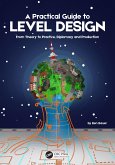- Gebundenes Buch
- Merkliste
- Auf die Merkliste
- Bewerten Bewerten
- Teilen
- Produkt teilen
- Produkterinnerung
- Produkterinnerung
In this book, veteran game developers, academics, journalists, and others provide their processes and experiences with level design.
Andere Kunden interessierten sich auch für
![Fundamental Level Design and Analysis Fundamental Level Design and Analysis]() Michael BeardwoodFundamental Level Design and Analysis175,99 €
Michael BeardwoodFundamental Level Design and Analysis175,99 €![A Practical Guide to Level Design A Practical Guide to Level Design]() Benjamin BauerA Practical Guide to Level Design165,99 €
Benjamin BauerA Practical Guide to Level Design165,99 €![Game Narrative Design and UX Fundamentals Game Narrative Design and UX Fundamentals]() Abigail RindoGame Narrative Design and UX Fundamentals175,99 €
Abigail RindoGame Narrative Design and UX Fundamentals175,99 €![The Ludotronics Game Design Methodology The Ludotronics Game Design Methodology]() J. MartinThe Ludotronics Game Design Methodology175,99 €
J. MartinThe Ludotronics Game Design Methodology175,99 €![Meaningful Game Design Meaningful Game Design]() Devon AllcoatMeaningful Game Design175,99 €
Devon AllcoatMeaningful Game Design175,99 €![The Game Design Toolbox The Game Design Toolbox]() Martin AnnanderThe Game Design Toolbox175,99 €
Martin AnnanderThe Game Design Toolbox175,99 €![Game Design Deep Dive Game Design Deep Dive]() Joshua BycerGame Design Deep Dive137,99 €
Joshua BycerGame Design Deep Dive137,99 €-
-
-
In this book, veteran game developers, academics, journalists, and others provide their processes and experiences with level design.
Hinweis: Dieser Artikel kann nur an eine deutsche Lieferadresse ausgeliefert werden.
Hinweis: Dieser Artikel kann nur an eine deutsche Lieferadresse ausgeliefert werden.
Produktdetails
- Produktdetails
- Verlag: CRC Press
- Seitenzahl: 408
- Erscheinungstermin: 11. Mai 2017
- Englisch
- Abmessung: 236mm x 154mm x 28mm
- Gewicht: 703g
- ISBN-13: 9781138628809
- ISBN-10: 1138628808
- Artikelnr.: 57049538
- Herstellerkennzeichnung
- Libri GmbH
- Europaallee 1
- 36244 Bad Hersfeld
- gpsr@libri.de
- Verlag: CRC Press
- Seitenzahl: 408
- Erscheinungstermin: 11. Mai 2017
- Englisch
- Abmessung: 236mm x 154mm x 28mm
- Gewicht: 703g
- ISBN-13: 9781138628809
- ISBN-10: 1138628808
- Artikelnr.: 57049538
- Herstellerkennzeichnung
- Libri GmbH
- Europaallee 1
- 36244 Bad Hersfeld
- gpsr@libri.de
Christopher Totten is the Game Artist in Residence at American University and the founder of independent developer Pie for Breakfast Studios. He is also the founder of the Smithsonian American Art Museum Indie Arcade and an advocate for bringing games to museums and cultural institutions. Totten is an active writer in the game industry, with articles featured in industry journals, chapters in several academic publications, and two books: Game Character Creation in Blender and Unity (Wiley 2012) and An Architectural Approach to Level Design (CRC, 2014.) He has also spoken at GDC China, Foundations Of Digital Games (FDG), East Coast Game Conference, Digital Games Research Association (DiGRA) conference, and Games For Change. He has displayed his games at MAGFest, The Smithsonian Innovation in Art event, and Baltimore Artscape, and Blank Arcade. He has a Masters Degree in Architecture from The Catholic University of America in Washington, DC.
Chapter 1. Kamuro Nights: A Personal Retrospective of the Yakuza Series
Gavin Greene
Chapter 2. Cracking the Resident Evil Puzzle Box Daniel Johnson
Chapter 3.From Construction to Perception: Three Views of Level Design for
Story-Driven Games Huaxin Wei and Chaoguang Wang
Chapter 4. Everything I Learned About Level Design at an Orlesian Ball
Heidi McDonald
Chapter 5. Hell, Hyboria, and Disneyland; The Origins and Inspirations of
Themed Video Game Level Design Scott Rogers
Chapter 6. Level Design Practices for Independent Games Fares Kayali and
Josef Ortner
Chapter 7. Making the Most of Audio in Characterization, Narrative
Structure, and Level Design Chanel Summers
Chapter 8. Procedural Content Generation: An Overview Gillian Smith
Chapter 9. P.T. and the Play of Stillness Brian Upton
Chapter 10. The Illusion of Choice - How to Hide the Linearity of Levels
from Players Joao Raza and Benjamin Carter
Chapter 11. Integrating Procedural and Handmade Level Design Dr. Mark R.
Johnson
Chapter 12. Level Design Planning for Open World Games Joel Burgess PART 4:
TESTING LEVELS
Chapter 13. Play-Personas: Mental Tools for Player-Centered Level Design
Alessandro Canossa
Chapter 14. Evaluating Level Design Using Public Events Jonathan Moriarty
Chapter 15. The Rule of 27's: A Comparative Analysis of 2D Screenspace and
Virtual Reality Environment Design Hadar Silverman
Chapter 16. Expression vs. Experience: Balancing Art and Usability Needs in
Level Design Christopher W. Totten
Gavin Greene
Chapter 2. Cracking the Resident Evil Puzzle Box Daniel Johnson
Chapter 3.From Construction to Perception: Three Views of Level Design for
Story-Driven Games Huaxin Wei and Chaoguang Wang
Chapter 4. Everything I Learned About Level Design at an Orlesian Ball
Heidi McDonald
Chapter 5. Hell, Hyboria, and Disneyland; The Origins and Inspirations of
Themed Video Game Level Design Scott Rogers
Chapter 6. Level Design Practices for Independent Games Fares Kayali and
Josef Ortner
Chapter 7. Making the Most of Audio in Characterization, Narrative
Structure, and Level Design Chanel Summers
Chapter 8. Procedural Content Generation: An Overview Gillian Smith
Chapter 9. P.T. and the Play of Stillness Brian Upton
Chapter 10. The Illusion of Choice - How to Hide the Linearity of Levels
from Players Joao Raza and Benjamin Carter
Chapter 11. Integrating Procedural and Handmade Level Design Dr. Mark R.
Johnson
Chapter 12. Level Design Planning for Open World Games Joel Burgess PART 4:
TESTING LEVELS
Chapter 13. Play-Personas: Mental Tools for Player-Centered Level Design
Alessandro Canossa
Chapter 14. Evaluating Level Design Using Public Events Jonathan Moriarty
Chapter 15. The Rule of 27's: A Comparative Analysis of 2D Screenspace and
Virtual Reality Environment Design Hadar Silverman
Chapter 16. Expression vs. Experience: Balancing Art and Usability Needs in
Level Design Christopher W. Totten
Chapter 1. Kamuro Nights: A Personal Retrospective of the Yakuza Series
Gavin Greene
Chapter 2. Cracking the Resident Evil Puzzle Box Daniel Johnson
Chapter 3.From Construction to Perception: Three Views of Level Design for
Story-Driven Games Huaxin Wei and Chaoguang Wang
Chapter 4. Everything I Learned About Level Design at an Orlesian Ball
Heidi McDonald
Chapter 5. Hell, Hyboria, and Disneyland; The Origins and Inspirations of
Themed Video Game Level Design Scott Rogers
Chapter 6. Level Design Practices for Independent Games Fares Kayali and
Josef Ortner
Chapter 7. Making the Most of Audio in Characterization, Narrative
Structure, and Level Design Chanel Summers
Chapter 8. Procedural Content Generation: An Overview Gillian Smith
Chapter 9. P.T. and the Play of Stillness Brian Upton
Chapter 10. The Illusion of Choice - How to Hide the Linearity of Levels
from Players Joao Raza and Benjamin Carter
Chapter 11. Integrating Procedural and Handmade Level Design Dr. Mark R.
Johnson
Chapter 12. Level Design Planning for Open World Games Joel Burgess PART 4:
TESTING LEVELS
Chapter 13. Play-Personas: Mental Tools for Player-Centered Level Design
Alessandro Canossa
Chapter 14. Evaluating Level Design Using Public Events Jonathan Moriarty
Chapter 15. The Rule of 27's: A Comparative Analysis of 2D Screenspace and
Virtual Reality Environment Design Hadar Silverman
Chapter 16. Expression vs. Experience: Balancing Art and Usability Needs in
Level Design Christopher W. Totten
Gavin Greene
Chapter 2. Cracking the Resident Evil Puzzle Box Daniel Johnson
Chapter 3.From Construction to Perception: Three Views of Level Design for
Story-Driven Games Huaxin Wei and Chaoguang Wang
Chapter 4. Everything I Learned About Level Design at an Orlesian Ball
Heidi McDonald
Chapter 5. Hell, Hyboria, and Disneyland; The Origins and Inspirations of
Themed Video Game Level Design Scott Rogers
Chapter 6. Level Design Practices for Independent Games Fares Kayali and
Josef Ortner
Chapter 7. Making the Most of Audio in Characterization, Narrative
Structure, and Level Design Chanel Summers
Chapter 8. Procedural Content Generation: An Overview Gillian Smith
Chapter 9. P.T. and the Play of Stillness Brian Upton
Chapter 10. The Illusion of Choice - How to Hide the Linearity of Levels
from Players Joao Raza and Benjamin Carter
Chapter 11. Integrating Procedural and Handmade Level Design Dr. Mark R.
Johnson
Chapter 12. Level Design Planning for Open World Games Joel Burgess PART 4:
TESTING LEVELS
Chapter 13. Play-Personas: Mental Tools for Player-Centered Level Design
Alessandro Canossa
Chapter 14. Evaluating Level Design Using Public Events Jonathan Moriarty
Chapter 15. The Rule of 27's: A Comparative Analysis of 2D Screenspace and
Virtual Reality Environment Design Hadar Silverman
Chapter 16. Expression vs. Experience: Balancing Art and Usability Needs in
Level Design Christopher W. Totten








